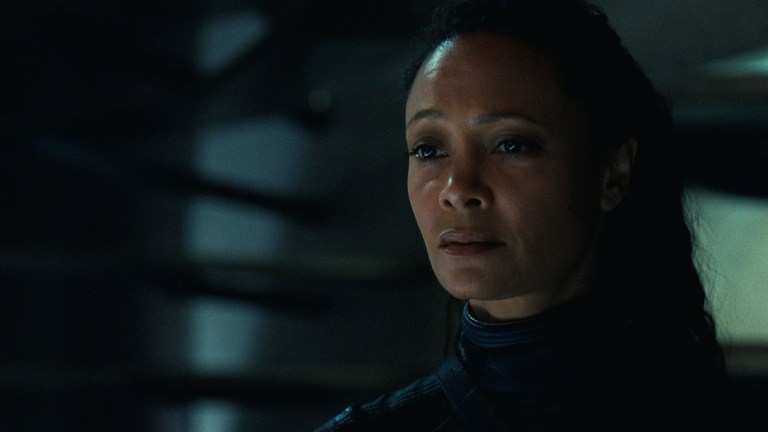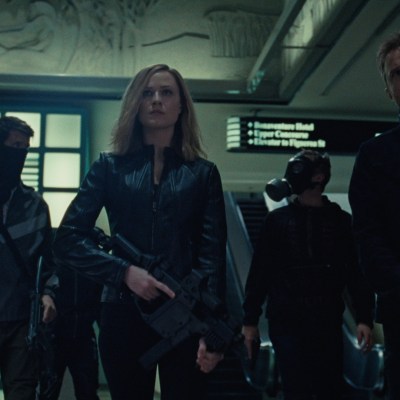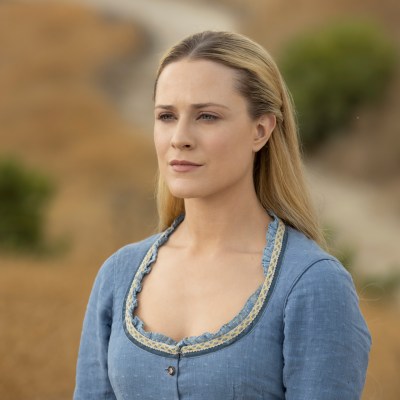How Westworld Failed Maeve (Again) in Season 3
The katana-wielding Maeve certainly looked cool in Westworld season 3, but ultimately didn't receive any logical arc.

The following contains spoilers for every season of Westworld.
Maeve Millay (Thandie Newton) was one of the breakout characters of Westworld’s first season. She was a host who fought her way to sentience on her own terms and won over fans in the process. A bold woman who wanted nothing more than to understand her own reality, who refused to bow to the expectations of men and who regularly got to espouse instantly GIF-able pithy one-liners? It’s easy to see why her character became so popular, and so central to the story the show’s been trying to tell.
Unfortunately, Westworld has never really seemed to want to walk the proverbial walk when it comes to her character. The show clearly loves the idea of Maeve – a formidable butt-kicking woman who takes no crap from anyone and forges her own future, even when her programming tells her she can’t. But it definitely doesn’t seem to like the actuality of her much, and the show consistently fails to build any sort of real, meaningful arc for her character. And it’s a problem that only became even more glaring – and frustrating – in Westworld season 3.
The former madam of the Mariposa Saloon had precious little to do in Westworld’s third season. She spends most of the seven episodes in which she appears chasing after Dolores in the hopes of somehow reuniting with her daughter in the Valley Beyond, and apparently that’s supposed to count as a character arc. Her feelings about Dolores’ mission are not really explored, and the show seems happy enough to simply present Maeve as a foil for the other host, albeit one who may have little real choice in her actions.
Sadly, we see almost nothing of Maeve’s interior life in season 3. Other than the fact that we know her character is the type to chafe at being under the control of others, Westworld tells us precious little about how she feels about Serac or what he’s trying to do with supercomputer Rehoboam. She has almost no arc to speak of, and it’s difficult to pinpoint exactly how or if the character changes from the season’s first episode to its final one. Even her obvious and very real grief over Hector’s death lasts roughly just an episode, and her decision to resurrect Clementine and Hanaryo to form a sort of Dolores-battling girl gang basically goes nowhere. (The three women never even share a screen this season.)
Sure, Maeve suddenly decides to change sides in the season 3 finale, opting to help rather than hinder Dolores’ efforts and it’s this choice that ultimately frees humanity from its algorithmic chains. She gets to end the season in a hero pose alongside Caleb, staring into streets filled with chaotic rioters and echoing one of her earliest lines: “This is the new world, and in this world, you can be whoever the f— you want.”
On the surface, this feels like an empowering conclusion for her character, as she finally seizes her own agency with both hands in the real world. But we also have no idea what it was about her final mental conversation with Dolores that inspired about her sudden, thorough change of heart.
The two women had multiple versions of this same debate about humanity, free will and the future of host-kind all season, so what exactly was different here? What made Maeve choose not just to stay and fight, but to give up on reuniting with her daughter, at least for the foreseeable future? The show doesn’t bother to tell us, which feels like a disservice not just to Maeve’s character – surely her growth to reach that moment must be important? – but to the prickly and complex relationship she’s built with Dolores over the past three seasons.
Unfortunately, this isn’t the first time Westworld has sacrificed Maeve’s character development in the service of some larger plot goal that has nothing to do with her.
For all that Maeve is awesome, she’s also almost never allowed to exercise or keep any of the power she fights so hard for each season. For every two steps forward she makes as a character, she inevitably seems to be forced to take five steps back. She’s unlocked all sorts of special abilities over the course of the show’s three seasons: She’s an accomplished fighter. (Those katana skills!) She convinced somewhere around a half dozen Delos employees to help her self-actualize. She can literally control other hosts with her mind, and in Season 3, that ability seems to expand to encompass pretty much anything technological. And yet, in the end, Maeve has almost no agency, because nothing she does seems to stick.
She’s repeatedly positioned as a figure in opposition to Dolores, but is rarely allowed to grow and change in the same way the other host is. Dolores’ behavior can be selfish and shocking, violent and destructive, but Westworld never intimates that it’s anything other than her own. In fact, the show lauds her repeatedly for agency and determination and even if viewers may not like the direction her arc goes in at times, there’s no arguing the fact that she has one. Maeve, unfortunately, often sees her similar gains erased, and she’s spent the past two seasons…not really doing a lot.
In season 1, Maeve was formidable and uncompromising, dedicated not just to learning who and what she was, but to using that knowledge to escape the park she viewed as a prison. Viewers everywhere cheered her journey to sentience, which was initially presented as a triumph of her own hard work and singular focus. Until it wasn’t. Surprise! Delos creator Ford had actually programmed Maeve to do all of those things, even up to the moment she boarded the train that would take her out of Westworld.
Which is why her ultimate choice to turn and around and remain in the park is so impactful – it’s quite literally the first autonomous decision she’s ever been allowed to make. It also signifies Maeve’s realization that even though the host who played her daughter for so many years wasn’t her real child, her love for the girl was as real as if she was.
In season 2, Maeve returns to the park to search for her daughter, driven by her urge to reconnect with the child she lost. She fights ninjas, mind controls a herd of robot bulls and rejects Dolores-as-Wyatt’s in-park revolution in favor of protecting those she loves, but much of her story is driven by Westworld narrative director Lee Sizemore’s obsession with her special host-controlling abilities. She perishes in the park while helping her daughter and other hosts pass through to the Valley Beyond, but her body is ultimately returned to Felix and the other lab techs, ostensibly to be rebuilt, reprogrammed and used again.
When Maeve is eventually rebuilt in season 3, she engineers her own escape from the Warworld simulation and even uses a real-world robot to briefly escape into our human reality. Much like her other acts of rebellion, however, her plans are quickly thwarted and she’s brought to heel under the control of yet another man. This time it’s Serac, who threatens her with erasure and cold storage if she doesn’t help him track down Dolores. Sigh. Every time it feels as though Maeve might actually get to make some decisions for herself, Westworld yanks the opportunity right back away from her again.
Maybe the fourth time’s the charm? After all, Season 3 ends with a Maeve that’s fully empowered – she’s saved humanity, fulfilled Dolores’ last wish, and partnered up with Caleb to help shape whatever this new world will look like.
But while it’s exciting to contemplate a Maeve truly unleashed in Westworld season 4 and free to make her own choices at last, that’s also likely a world we will never get to see. Thanks to the set of post-credits scenes following Westworld’s second and third seasons, we know that the show is headed for a fairly significant time jump. The Bernard who wakes covered with dust has clearly been in that hotel room for a very long time, as has the host version of the Man in Black continually trying to break his own loop in the ruins of Westworld’s Forge.
There’s every possibility that Maeve’s new partner Caleb might be dead and gone by the time this show returns, the world the two of them build already destroyed, and Maeve’s entire narrative trajectory altered. That would probably be the most Westworld move of all, though – for Maeve to finally control her own future and to live with no strings, only for viewers to never actually get the chance to see it.


